BizSpark Partners and Microsoft Accelerator In The News
It's been a heavy media day around here. Some reporters from Endgadget and Bloomberg just got back from their trip to see the Microsoft Accelerator in Seattle.
The Endgadget piece focuses on several of the startup accelerator participants, like Freak'nGenius:
Freak'n Genius co-founder Kyle Kesteron is a former illustrator and toy developer and current entrepreneur. The genesis of his company dates back to November of last year, when he participated in a Seattle Startup Weekend and emerged with a couple of partners and an idea for a platform that lets people create their own high-quality cartoons. You see, animation is a difficult, labor intensive process that requires a unique set of skills, but with a bit of software and a Kinect sensor bar, most anyone can create South Park-style animations.
And GestSure Technologies:
Enter Jamie Tremaine, a mechanical engineer, whose mind began to reel with the potential provided by Kinect back in November of 2010. The week of Kinect's release, Tremaine was out running with his buddies, general surgeon Dr. Matt Strickland and software engineer Greg Brigley, and the idea to leverage Kinect's gesture controls for use in operating rooms was hatched. GestSure Technologies was the result of that jogging epiphany, and within three weeks the first prototype was built.
The box itself is essentially a computer that serves USB bridge to connects the Kinect to existing hospital PCs used to interact with CT and MRI data. Its secret sauce maps gestures to mouse commands to allow surgeons to navigate through the images in the OR hands-free -- which means they no longer have to scrub out or wait for a nurse to obtain the info they need, saving valuable time in the process. It works using an embedded image processor to interpolate the Kinect data and shoot commands to the PC over USB 2.0, so it's a plug-and-play solution that requires no new drivers be installed on existing hospital computers. The device has already been tested in operating rooms, and FDA registration of the device is expected to be complete in less than two weeks. After that, the devices can be sold implemented in medical facilities all over the US.
They are all startups using Kinect technologies, but the point is, they are getting months of hands-on experience with Microsoft technical teams and TechStars mentors, in Seattle, three floors up from a coffee shop.
Bloomberg shows how hands-on they are getting:
Microsoft already has several hundred companies writing applications for Kinect for Windows, but the company wanted an accelerator program that harnessed the imagination of the startup world, which is often more daring in its endeavors.
“They’ll look at problems that are bigger risks than regular companies,” said Craig Eisler, general manager of Kinect for Windows.
Developers are key to Microsoft’s ambition of making Kinect more than a gaming device. In order for Kinect to play a central role in the future of computing, Microsoft needs startups tobuild applications that make gesture-based controls and 3-D scanning important to non-gamers.
Microsoft isn’t alone. San Francisco-based Leap Motion today announced a $70 3-D motion control device and is seeking developers to build applications around its technology.
For a company that lacks the app developer appeal of an Apple, Kinect has been a bright spot for Microsoft. Nearly 500 startups applied for the accelerator program, which is co-hosted by TechStars, a program that nurtures young companies. Whether or not venture capitalists and customers will also flock to this technology remains to be seen.
And we would be remiss if we didn't share this link to a great post about a company that was down to its last .72 cents before they got their funding round, brought to us by our network partner, Founder Dating.
